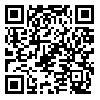Volume 13, Issue 2 (4-2025)
J. Pediatr. Rev 2025, 13(2): 145-150 |
Back to browse issues page
Download citation:
BibTeX | RIS | EndNote | Medlars | ProCite | Reference Manager | RefWorks
Send citation to:



BibTeX | RIS | EndNote | Medlars | ProCite | Reference Manager | RefWorks
Send citation to:
Edalatkhah R, Sadatmoosavi N, Pourshamsi F. Examining the Association Between Anxiety Severity and Required Sedative Medication Dosage in Children Undergoing Upper Gastrointestinal Endoscopy. J. Pediatr. Rev 2025; 13 (2) :145-150
URL: http://jpr.mazums.ac.ir/article-1-618-en.html
URL: http://jpr.mazums.ac.ir/article-1-618-en.html
1- Hematology and Oncology Research Center, Shahid Sadoughi University of Medical Sciences, Yazd, Iran. , Drr.edalatkhah@gmail.com
2- Shahid Sadoughi General Hospital, Shahid Sadoughi University of Medical Sciences, Iran, Yazd.
2- Shahid Sadoughi General Hospital, Shahid Sadoughi University of Medical Sciences, Iran, Yazd.
Abstract: (1231 Views)
Background: With the advancement and widespread adoption of new technologies in recent decades, there has been an increased utilization of diagnostic and therapeutic methods, such as upper gastrointestinal endoscopy (UGE). UGE is a procedure commonly employed for the diagnosis and treatment of various digestive disorders; however, it can induce anxiety and fear in both children and their parents.
Objectives: This study examines the association between anxiety severity and the necessary dosage of sedative medications in children undergoing UGE.
Methods: This study assessed the anxiety levels in children aged 3-7 years undergoing diagnostic endoscopy of the upper gastrointestinal tract. Before the endoscopy procedure, the intensity of anxiety was measured using the preschool anxiety score questionnaire. Sedation was achieved using propofol, with an initial dose of 2 mg/kg and an additional dose of 0.5 mg/kg if necessary. The total dose of propofol required to achieve deep sedation, as well as the duration of the endoscopy procedure, recovery time, and any sedation-related complications, were assessed and recorded for each patient.
Results: The present study included 50 children (48% boys, 52% girls) with a mean age of 5 years and 1 month, who were scheduled for UGE. There was no significant correlation between the intensity of anxiety and the variables of age and gender (P of 0.20 and 0.766, respectively). However, a significant relationship was observed between the intensity of anxiety and the following factors: The need for an additional dose of propofol, duration of the endoscopy procedure, recovery time, and sedation-related complications (P<0.001, 0.027, 0.048, and 0.001, respectively). Among the sedation-related complications, irritability was the most frequently reported, occurring in 19 cases (38% frequency).
Conclusions: The findings of this study suggest a significant association between pre-endoscopy anxiety levels and several factors, including propofol dosage, endoscopy duration, recovery time, and sedation-related complications. These results indicate that implementing anxiety-reducing interventions may potentially reduce the requirement for high doses of anesthetics and mitigate associated side effects.
Objectives: This study examines the association between anxiety severity and the necessary dosage of sedative medications in children undergoing UGE.
Methods: This study assessed the anxiety levels in children aged 3-7 years undergoing diagnostic endoscopy of the upper gastrointestinal tract. Before the endoscopy procedure, the intensity of anxiety was measured using the preschool anxiety score questionnaire. Sedation was achieved using propofol, with an initial dose of 2 mg/kg and an additional dose of 0.5 mg/kg if necessary. The total dose of propofol required to achieve deep sedation, as well as the duration of the endoscopy procedure, recovery time, and any sedation-related complications, were assessed and recorded for each patient.
Results: The present study included 50 children (48% boys, 52% girls) with a mean age of 5 years and 1 month, who were scheduled for UGE. There was no significant correlation between the intensity of anxiety and the variables of age and gender (P of 0.20 and 0.766, respectively). However, a significant relationship was observed between the intensity of anxiety and the following factors: The need for an additional dose of propofol, duration of the endoscopy procedure, recovery time, and sedation-related complications (P<0.001, 0.027, 0.048, and 0.001, respectively). Among the sedation-related complications, irritability was the most frequently reported, occurring in 19 cases (38% frequency).
Conclusions: The findings of this study suggest a significant association between pre-endoscopy anxiety levels and several factors, including propofol dosage, endoscopy duration, recovery time, and sedation-related complications. These results indicate that implementing anxiety-reducing interventions may potentially reduce the requirement for high doses of anesthetics and mitigate associated side effects.
Type of Study: Original Article |
Received: 2025/01/2 | Accepted: 2025/03/3 | Published: 2025/04/1
Received: 2025/01/2 | Accepted: 2025/03/3 | Published: 2025/04/1
Send email to the article author
| Rights and permissions | |
 |
This work is licensed under a Creative Commons Attribution-NonCommercial 4.0 International License. |









